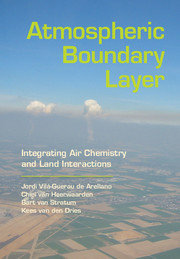Description
Atmospheric Boundary Layer
Integrating Air Chemistry and Land Interactions
Authors: Vilà-Guerau de Arellano Jordi, van Heerwaarden Chiel C., van Stratum Bart J. H., van den Dries Kees
This textbook and software provide an introduction to the soil-land-vegetation-atmosphere system for advanced students and researchers in atmospheric science, hydrology and plant physiology.
Language: English
Subject for Atmospheric Boundary Layer:
72.36 €
In Print (Delivery period: 14 days).
Add to cart
Publication date: 06-2015
276 p. · 18.3x26.1 cm · Hardback
276 p. · 18.3x26.1 cm · Hardback
Description
/li>Contents
/li>Biography
/li>
Based on more than twenty years of research and lecturing, Jordi Vilà-Guerau de Arellano and his team's textbook provides an excellent introduction to the interactions between the atmosphere and the land for advanced undergraduate and graduate students and a reference text for researchers in atmospheric physics and chemistry, hydrology, and plant physiology. The combination of the book, which provides the essential theoretical concepts, and the associated interactive Chemistry Land-surface Atmosphere Soil Slab (CLASS) software, which provides hands-on practical exercises and allows students to design their own numerical experiments, will prove invaluable for learning about many aspects of the soil-vegetation-atmosphere system. This book has a modular and flexible structure, allowing instructors to accommodate it to their own learning-outcome needs.
Part I. The Land-Atmospheric Boundary Layer System: 1. Seeking interdisciplinary connections; Part II. The Uncoupled System: 2. Atmospheric boundary layer dynamics; 3. Atmospheric boundary layer chemistry; 4. Potential temperature budget: diurnal variation of temperature; 5. Moisture budget: diurnal variation of specific moisture; 6. Momentum budget: diurnal variation of wind; 7. Scalar and CO2 budget: contributions of surface, entrainment and advection; 8. Reactant budget: diurnal variation of ozone; Part III. The Coupled System: 9. Atmosphere-vegetation-soil interaction; 10. Numerical experiments: atmosphere-vegetation-soil interaction; 11. Representing dynamically the vegetation and soil exchanges of carbon dioxide; 12. Sensitivity of the atmosphere-vegetation-soil system to climate perturbations; 13. Case studies of more complex situations; Part IV. Processes Related to Boundary Layer Clouds: 14. The cloud-topped boundary layer: stratocumulus; 15. The scatter cloud-topped boundary layer: shallow cumulus; Part V. User's Guide: CLASS Modules and Variables: 16. CLASS modules; Appendices; Bibliography; Index.
Jordi Vilà-Guerau de Arellano is a member of the Meteorology and Air Quality Section at Wageningen University in the Netherlands. He has over twenty years of research and teaching experience in the fields of atmospheric modeling and the atmospheric boundary layer. He has written more than eighty papers, placing special emphasis on cross-disciplinary activities in land and atmospheric science.
Chiel C. van Heerwaarden is a member of the Meteorology and Air Quality Section at Wageningen University in the Netherlands. He has made fundamental contributions to integrating our understanding of land and atmospheric processes, with special emphasis on the development of conceptual and numerical models.
Bart J. H. van Startum is a member of the Meteorology and Air Quality Section at Wageningen University in the Netherlands. He is currently researching several aspects of shallow convection.
Kees van den Dries is a member of the Meteorology and Air Quality Section at Wageningen University in the Netherlands. He is a specialist in atmospheric chemistry.
Chiel C. van Heerwaarden is a member of the Meteorology and Air Quality Section at Wageningen University in the Netherlands. He has made fundamental contributions to integrating our understanding of land and atmospheric processes, with special emphasis on the development of conceptual and numerical models.
Bart J. H. van Startum is a member of the Meteorology and Air Quality Section at Wageningen University in the Netherlands. He is currently researching several aspects of shallow convection.
Kees van den Dries is a member of the Meteorology and Air Quality Section at Wageningen University in the Netherlands. He is a specialist in atmospheric chemistry.
© 2024 LAVOISIER S.A.S.
These books may interest you

Fundamentals of Meteorology 147.69 €

Fundamentals of Meteorology 147.69 €


